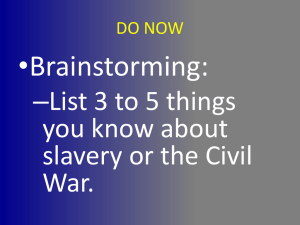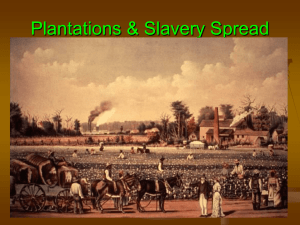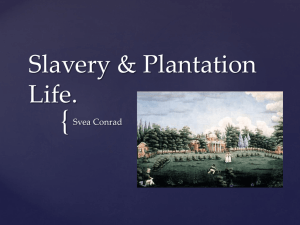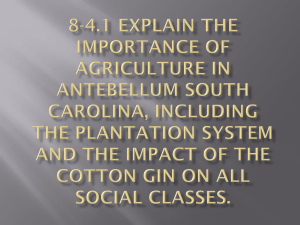The Plantation South
advertisement
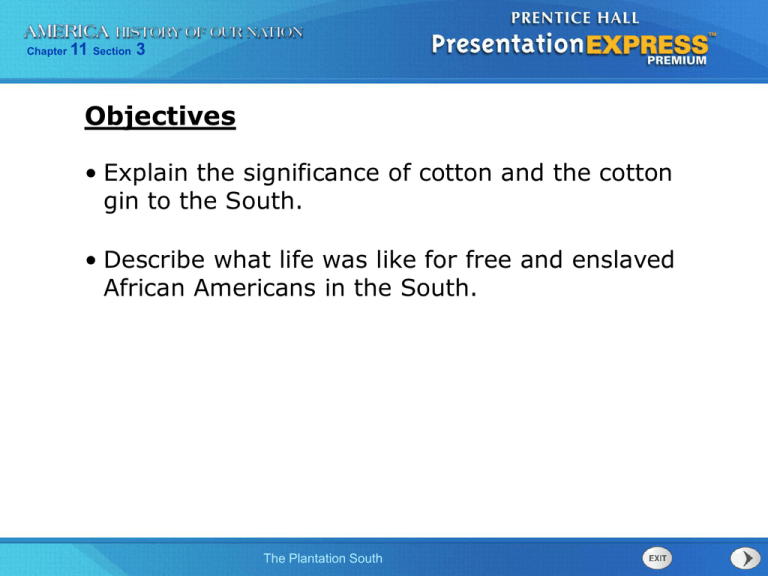
Chapter 11 Section 3 Objectives • Explain the significance of cotton and the cotton gin to the South. • Describe what life was like for free and enslaved African Americans in the South. The Plantation South Chapter 11 Section 3 Terms and People • cotton gin – a machine that used a spiked cylinder to remove seeds from cotton fibers • slave code – laws that controlled every aspect of the lives of enslaved African Americans • spiritual – a religious folk song that blended biblical themes with the realities of slavery • Nat Turner – a slave who led a famous slave revolt in 1831 The Plantation South Chapter 11 Section 3 Warm Up Questions Directions: Answer the following on a piece of paper. 1. Why would slave owners want their slaves to be healthy? 2. How did the cotton gin affect cotton production? 3. What were slave codes? 4. What could happen to runaway slaves and even free Africans? Use pages 396 - 400 if needed The Plantation South Chapter 11 Section 3 How did cotton affect the social and economic life of the South? A boom in textiles caused by the Industrial Revolution created a huge demand for cotton. The South’s economy became dependent on cotton, and cotton plantations became dependent on slave labor. The Plantation South Chapter 11 Section 3 In the North, the Industrial Revolution caused industry, immigration, and cities to grow. The South remained largely rural as its plantations grew wealthy from the cotton trade. The Plantation South Chapter 11 Section 3 The Cotton Gin Before the introduction of the cotton gin, laborers had to pick seeds out of the cotton by hand, which was a very slow process. In 1793, Eli Whitney invented the cotton gin. The cotton gin greatly sped up the processing of cotton and made it much more profitable. The Plantation South Chapter 11 Section 3 In 1790, planters grew 1.5 million pounds of cotton, but by 1820, they grew ten times as much. The Plantation South Chapter 11 Section 3 Cotton became the greatest source of wealth for the United States, enriching: Northern bankers and ship owners Southern planters The Plantation South Chapter 11 Section 3 To keep up with the demand for cotton and the new ability to process it quickly, planters used more slave labor. From 1790 to 1860, the price of a slave increased ten or twenty times. The Plantation South Chapter 11 Section 3 Enslaved African Americans Enslaved African Americans had no rights at all, and their lives were controlled by slave codes. The Plantation South Chapter 11 Section 3 An Extreme Case…… The Plantation South Chapter 11 Section 3 Lives of Enslaved African Americans in the South Tasks • Some enslaved African Americans worked in their owners’ homes. • Most did heavy farm labor. Working conditions • Some slave holders worked slaves almost to death and whipped them as punishment for many offenses. • Most owners saw their slaves as valuable property and tried to keep them healthy so they would be productive. Families • Owners often broke apart slave families by selling family members. The Plantation South Chapter 11 Section 3 The Plantation South Chapter 11 Section 3 The Plantation South Chapter 11 Section 3 The Plantation South Chapter 11 Section 3 The Plantation South Chapter 11 Section 3 The Plantation South Chapter 11 Section 3 Enslaved African Americans passed on African customs, music, and dance to their children. Many African Americans found messages of hope in the Bible, and they composed spirituals. The Plantation South Chapter 11 Section 3 Many enslaved African Americans resisted slave holders by working slowly, breaking equipment, fleeing to freedom in the north, and rebelling. In 1831, Nat Turner said he was told to kill whites in a vision. He led a famous, but doomed, slave revolt. Whites retaliated by killing many innocent African Americans. The Plantation South Chapter 11 Section 3 Abolition Movement - Movement to end slavery in America After 1808, it was illegal to import enslaved Africans to the United States. By the 1830s, some northerners were pushing for slavery to be banned. The Plantation South Chapter 11 Section 3 Supporters of slavery said that it was more humane than the free labor system of the North. The Plantation South Critics of slavery said that slaves suffered abuse from white owners. Chapter 11 Section 3 Most southern whites accepted the system of slavery, fearing violent uprisings would follow if control over slaves was weakened. The Plantation South Chapter 11 Section 3 About 6 percent of the 4 million African Americans in the South were free. Many of the free African Americans made valuable contributions to southern life: • Norbert Rillieux improved sugar refining. • Henry Blair invented a seed-planting device. The Plantation South Chapter 11 Section 3 Obstacles Faced by Free African Americans in the South Jobs • Free African Americans were given only the most menial jobs. Travel • They were discouraged from traveling. Education • Their children could not attend public schools. Political Rights • They could not vote, serve on juries, or testify against white defendants in court. Liberty • Slave catchers often kidnapped them and sold them into slavery. The Plantation South Chapter 11 Section 3 In the southern “Cotton Kingdom,” society was dominated by a small group of wealthy plantation owners. But more than half of all southern farmers did not have slaves. Instead of growing cotton, these people often grew corn and raised hogs and chickens. The Plantation South Chapter 11 Section 3 Differences Between Southern States Alabama, Mississippi, and Like States • States that depended heavily on cotton had large populations of enslaved people. Kentucky and Like States • States that grew less cotton had smaller populations of enslaved people. The Plantation South Chapter 11 Section 3 Journal Activity Directions: Write a 5 sentence journal entry as if you were a slave on a Southern cotton plantation. Include your relationship with your owner, what your job is like and the working and living conditions you face. Hand in your journal entry at the end of the period. (PAGE 399) The Plantation South Chapter 11 Section 3 Section Review QuickTake Quiz The Plantation South Know It, Show It Quiz


